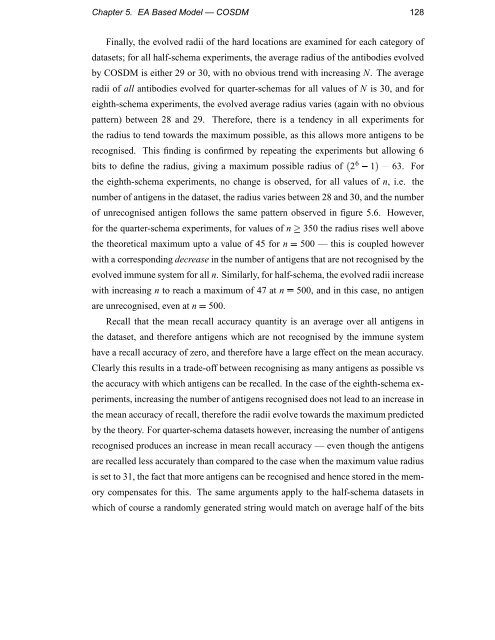Immunology as a Metaphor for Computational ... - Napier University
Immunology as a Metaphor for Computational ... - Napier University
Immunology as a Metaphor for Computational ... - Napier University
Create successful ePaper yourself
Turn your PDF publications into a flip-book with our unique Google optimized e-Paper software.
Chapter 5. EA B<strong>as</strong>ed Model — COSDM 128Finally, the evolved radii of the hard locations are examined <strong>for</strong> each category ofdat<strong>as</strong>ets; <strong>for</strong> all half-schema experiments, the average radius of the antibodies evolvedby COSDM is either 29 or 30, with no obvious trend with incre<strong>as</strong>ing N. The averageradii of all antibodies evolved <strong>for</strong> quarter-schem<strong>as</strong> <strong>for</strong> all values of N is 30, and <strong>for</strong>eighth-schema experiments, the evolved average radius varies (again with no obviouspattern) between 28 and 29. There<strong>for</strong>e, there is a tendency in all experiments <strong>for</strong>the radius to tend towards the maximum possible, <strong>as</strong> this allows more antigens to berecognised. This finding is confirmed by repeating the experiments but allowing 6bits to define the radius, giving a maximum possible radius of 2 6 1¥ 63. Forthe eighth-schema experiments, no change is observed, <strong>for</strong> all values of n, i.e. the£number of antigens in the dat<strong>as</strong>et, the radius varies between 28 and 30, and the numberof unrecognised antigen follows the same pattern observed in figure 5.6. However,<strong>for</strong> the quarter-schema experiments, <strong>for</strong> values of n 350 the radius rises well abovethe theoretical maximum upto a value of 45 <strong>for</strong> n 500 — this is coupled howeverwith a corresponding decre<strong>as</strong>e in the number of antigens that are not recognised by theevolved immune system <strong>for</strong> all n. Similarly, <strong>for</strong> half-schema, the evolved radii incre<strong>as</strong>ewith incre<strong>as</strong>ing n to reach a maximum of 47 at n 500, and in this c<strong>as</strong>e, no antigenare unrecognised, even at n 500.Recall that the mean recall accuracy quantity is an average over all antigens inthe dat<strong>as</strong>et, and there<strong>for</strong>e antigens which are not recognised by the immune systemhave a recall accuracy of zero, and there<strong>for</strong>e have a large effect on the mean accuracy.Clearly this results in a trade-off between recognising <strong>as</strong> many antigens <strong>as</strong> possible vsthe accuracy with which antigens can be recalled. In the c<strong>as</strong>e of the eighth-schema experiments,incre<strong>as</strong>ing the number of antigens recognised does not lead to an incre<strong>as</strong>e inthe mean accuracy of recall, there<strong>for</strong>e the radii evolve towards the maximum predictedby the theory. For quarter-schema dat<strong>as</strong>ets however, incre<strong>as</strong>ing the number of antigensrecognised produces an incre<strong>as</strong>e in mean recall accuracy — even though the antigensare recalled less accurately than compared to the c<strong>as</strong>e when the maximum value radiusis set to 31, the fact that more antigens can be recognised and hence stored in the memorycompensates <strong>for</strong> this. The same arguments apply to the half-schema dat<strong>as</strong>ets inwhich of course a randomly generated string would match on average half of the bits









![Unit 5. Switches and VLANs [PDF]](https://img.yumpu.com/34422504/1/184x260/unit-5-switches-and-vlans-pdf.jpg?quality=85)






